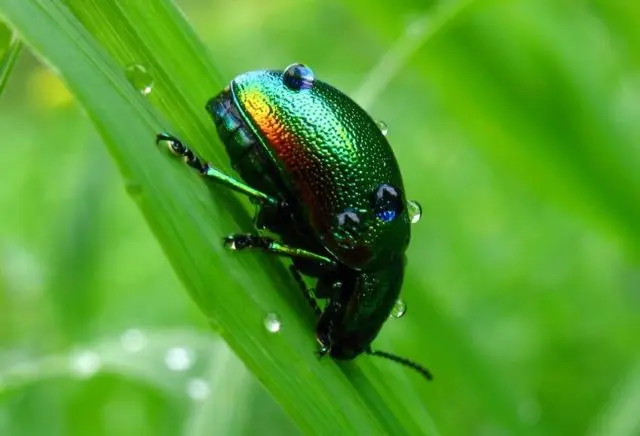Contents
Narrow-leaved lavender is a type of evergreen perennial herbaceous subshrub with delicate silvery foliage and fragrant spikelets, consisting of small purple, lilac, pink, blue or white flowers. The medicinal and spicy-aromatic properties of this plant are well known, thanks to which it is actively used in medicine, perfumery and cooking. Lavender narrow-leaved is very decorative, frost-resistant and unpretentious.
It is not surprising that this species is the most common in Our Country. Angustifolia lavender is grown in the fields on an industrial scale. It is planted in decorative compositions, decorating parks, gardens, household plots. If you try a little, you can keep this delicate and pleasantly smelling flower in a flowerpot on the window of a city apartment. There are many cultivars of narrow-leaved lavender with improved characteristics, including selection. Among them, you can choose the most suitable for growing in a particular region.
Description of angustifolia lavender
Lavender angustifolia (in Latin Lavandula angustifolia) is one of the 47 species that make up the genus Lavender, which is part of the Lamiaceae (Lyasnotkovye) family. In another way, it is also known under the names of English lavender, real lavender, spikelet lavender (spike, spike).
This species got its main name because of the characteristic narrow leaf shape. For the first time, its description was compiled by the English botanist Philip Miller in 1768. A photo of narrow-leaved lavender will help you understand what this plant is.
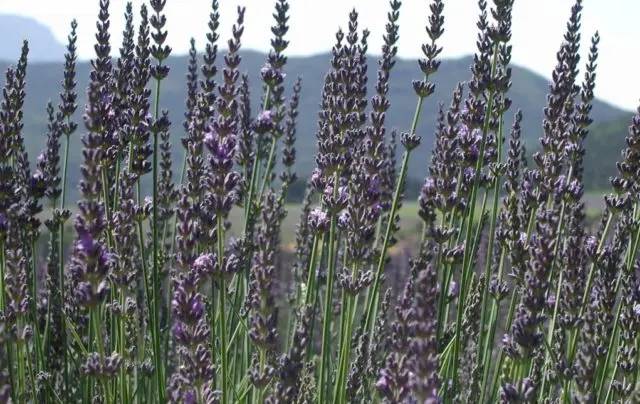
Lavender angustifolia (English) is a very decorative and fragrant evergreen subshrub that can become an exquisite decoration for any corner of the garden.
It is an evergreen, perennial, herbaceous subshrub from 30 to 60 (sometimes up to 100) cm in height. The shoots of the plant branch strongly, due to which the crown has a magnificent spherical shape. Lavender angustifolia lacks a central stem. Its powerful, lignified lower branches rise slightly above the ground and bear numerous young shoots of white-gray color, tending upwards. Their surface is slightly pubescent. The number of shoots on one plant can reach 400 pieces.
Lavender angustifolia has a tap root system. It is dense and powerful, but at the same time it strongly branches in the upper part.
The leaves of the plant are thin, narrow, with slightly curved edges. When blooming, they are pubescent, like shoots, and have a gray-green color, then become naked and bright green. The length of the leaves of narrow-leaved lavender varies from 2 to 6 cm. They are located oppositely.
The flower shoots of the plant have a markedly elongated upper internode. Inflorescences are located on their tops. They have a spike shape.
Flowering of angustifolia lavender lasts 25-30 days. Usually it can be observed in July-August. The flowers are small, about 1 cm long, combined in false whorls of 6 pieces. They have elongated two-lipped corollas with large lobes. As a rule, they are blue-violet in color, although there are varieties of narrow-leaved lavender with purple, blue, pink, and white flowers.
The fruit of the plant is 4 nuts located inside the cup. Their ripening period is August-September.
The life expectancy of narrow-leaved lavender in nature is 20-30 years.
Differences between broadleaf and narrowleaf lavender
When they pronounce the word “lavender”, they most often mean narrow-leaved. However, not only this species is known in culture.
Broad-leaved lavender (Lavandula latifolia), often called French lavender, is grown in large quantities in the south of this country and used to produce essential oil. It is distinguished by such features:
- on each stem of broad-leaved lavender there are 3 inflorescences (for narrow-leaved – one each);
- its spikelets are shorter and denser;
- flowering begins earlier;
- leaves wider, lanceolate;
- the petals of its upper flowers stick up like the wings of a butterfly;
- its aroma is stronger and sharper, it has pronounced notes of camphor;
- she is more affectionate.

Broadleaf lavender (French) is less winter hardy than English lavender and has a stronger aroma.
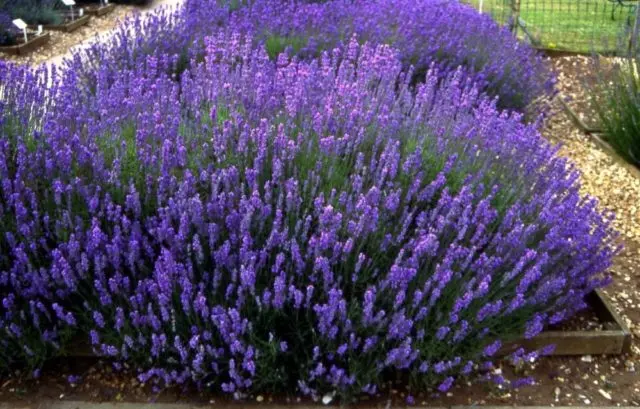
Lavandin is a hybrid of narrow-leaved and broad-leaved lavender.
Varieties of narrow-leaved lavender
To date, many varieties of narrow-leaved lavender are known, which differ in height, bush shape, degree of aroma, flowering time, and flower color. Most of them are bred in England, France, Spain. However, there are several excellent varieties, both of domestic origin and from neighboring countries, released in various regions of Our Country.
Munstead
Lavender angustifolia Munstead (Munstead, Munstead) was bred in 1916 by the famous English garden designer Gertrude Jekyll. This variety does not grow tall – only up to 30-40 cm. Very fragrant flowers are painted in a rich blue-violet tone and appear in July-August.
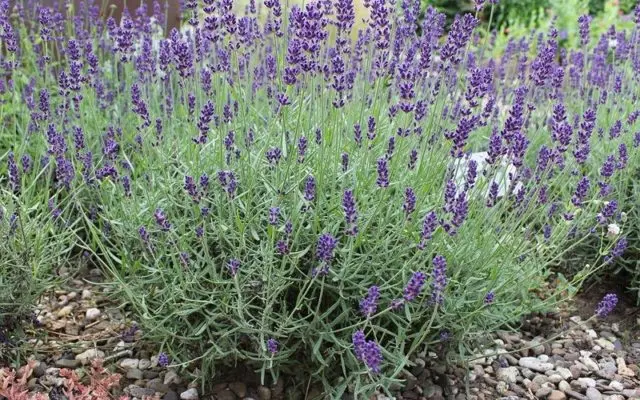
Munstead – an extremely beautiful low variety
Hidcote
Hidcote (Hidcoat) – one of the most popular varieties of narrow-leaved lavender in the world, was named after the estate of its originator, the Englishman Lawrence Johnston. Reaches 30-60 cm in height and about 1 m in diameter. It has a very persistent pleasant aroma. Its dark purple flowers look exceptionally decorative against the dense blue-green foliage. In climates with warm, mild winters, this plant remains evergreen.
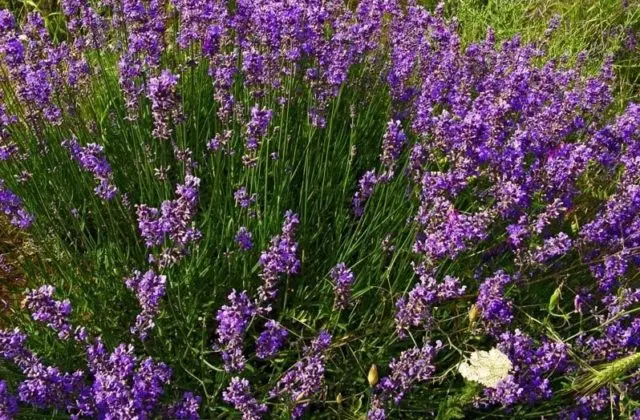
Hidkot – one of the most popular varieties in the world
Folgate
Folgate lavender bush with a dense spherical crown usually grows to 30-70 cm. Its petals, painted in a violet-blue hue, shimmer in bright light, due to which these flowers look very beautiful in the cut. This variety has a fragrant, sweetish aroma. Flowering begins early, in late spring or early summer. It is Folgate narrow-leaved lavender that is most often used in cooking. A significant drawback is that in open ground it does not tolerate winters of the middle climatic zone.
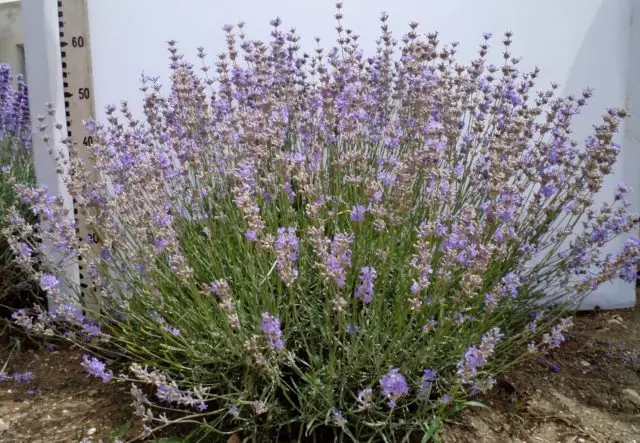
Blue-purple Folgate flowers shimmer in bright light
Buena Vista
The flowers of the Buena Vista variety have an unusual color: dark purple cups and violet-blue corollas. This is a medium-sized lavender (50-60 cm). Thanks to its repeated flowering, late spring and early autumn, as well as its high oil content, it is actively grown for industrial purposes.
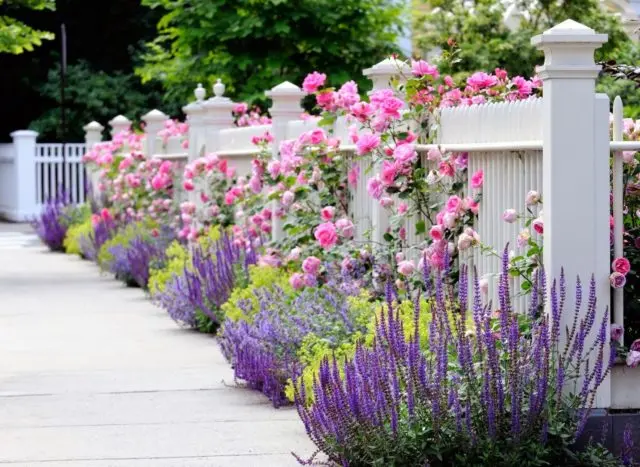
In the color of the flowers of the Buena Vista variety, two tones are combined
Dwarf Blue
Dwarf Blue (Dwarf Blue) – compact (up to 40 cm), frost-resistant variety of narrow-leaved lavender. Delicate purple flowers look beautiful against the background of silver-green leaves. Resistant to air pollution, and therefore suitable for ornamental cultivation in urban gardens. Can be planted in pots and containers. Blooms in June-July. Handles cutting well.

Soft purple Dwarf Blue is resistant to air pollution and great for urban plantings
Ellagance
Elagance is a group of lavender varieties with an narrow-leaved height of 30-60 cm. Ellagance Pink has pale pink flowers, Ellagance Ice has dark blue or snow-white flowers, Ellagance Sky has lilac-purple flowers, in Ellagance Purple – rich lilac. They are grown mainly for decorative purposes.
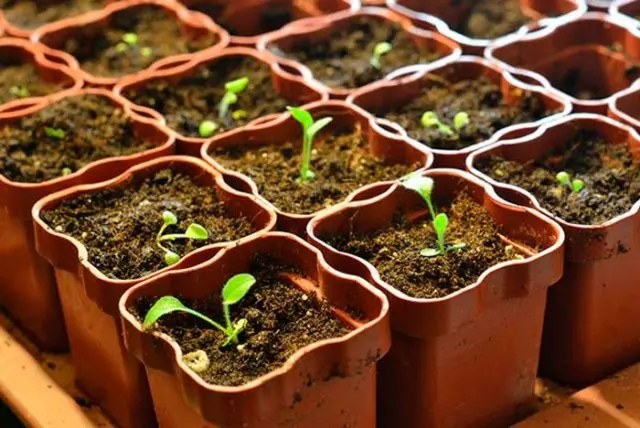
Elagans Ice will surprise you with a snow-white color
Voznesenskaya 34
Variety of domestic selection, bred in the Krasnodar Territory. It was entered into the State Register in 1962. This is a low-growing variety, the height of the bush does not exceed 30 cm. Dense twigs, forming an almost spherical crown, are covered with gray-green leaves. Bright numerous inflorescences of purple-lilac color adorn this lavender in June-July. Great for growing in all regions of Our Country.

Voznesenskaya 34 – a popular industrial variety of domestic selection
Stepnaya
The originator of the variety is the Crimean Research Institute of Agriculture. It was included in the State Register of the Federation in 2014. It is recommended for cultivation in the North Caucasus region. Plant height – up to 60 cm, crown shape – semi-spreading. The flowers of this variety of narrow-leaved lavender are painted in light lilac tones. It is characterized by medium ripeness and a high content of essential oils. It is considered not too winter hardy.
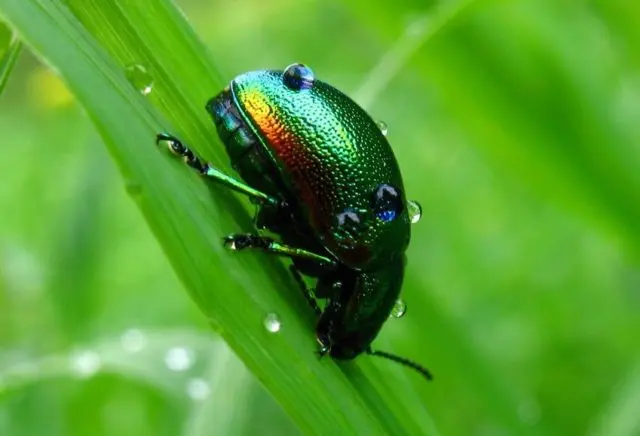
The narrow-leaved lavender variety Stepnaya is famous not only for the beauty of the flowers, but also for the high content of essential oil.
Early
Early ripe lavender, created by breeders of the Crimea on the basis of the Stepnaya variety. Date of inclusion in the State Register – 1980. The height of the bush is average (30-60 cm), the corollas of flowers are light purple, the calyxes are gray-green. Due to its high yield and good winter hardiness, the variety has established itself as an industrial variety. An additional positive feature is resistance to septoria.

Rannaya is a winter-hardy and early-flowering hybrid of the Stepnaya variety
Isis
A hybrid of narrow-leaved lavender, obtained by Crimean breeders as a result of crossing the varieties Druzhba, Stepnaya and Hemus. Introduced into the State Register of the Federation in 2000, zoned for cultivation in the North Caucasus region. It grows up to 69-70 cm in height. Late ripe variety. Flowers are dark purple. Great for seed propagation. The results of the variety trials showed that the parameters of the collection of essential oil of Izida were even higher than those of Stepnaya.
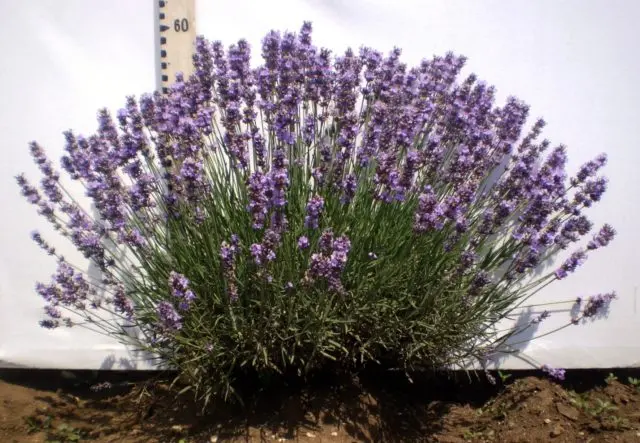
Variety Izida retains most of the characteristics when propagated by seeds
Features of reproduction
There are several ways to propagate lavender angustifolia:
- sowing seeds;
- cuttings;
- dividing the bush;
- rooting cuttings.
Growing from seeds is the longest and most laborious option for obtaining young plants. In ornamental gardening, the seedling method is usually used, but sowing directly into the ground is also allowed.
It is much easier to carry out cuttings of a plant. To do this, in June-July, annual shoots are cut from a young bush of an narrow-leaved variety. They are divided into cuttings about 10 cm long and the leaves are removed at the base. The lower cut of each of them is dipped in Kornevin and rooted under a film in a greenhouse with fertile soil, providing abundant watering and ventilation for 3-5 weeks. As a rule, by the end of August, young plants with an overgrown root system are planted in a permanent place of growth, so that before the onset of winter they have time to gain strength.
You can share adults, 3-4-year-old narrow-leaved lavender bushes. This procedure is performed in spring or autumn. The bush should be dug out with a clod of earth and carefully cut into 2 or more parts with a sterile sharp knife or pruner. It is important that each of the divisions has well-developed roots. They should be cut a little before planting the plants in a new place.
Lavender angustifolia layering rooted in the spring. Shallow grooves are dug in the ground near the selected bush. Several long shoots are carefully deflected to the side, placed in prepared holes and pinned or pressed to the ground with a small load. Then the layers are sprinkled with soil, leaving their tops on the surface. Further, it is imperative to ensure that the soil around the bush and dug shoots does not dry out. Lavender angustifolia will take root the following spring. They can be separated from the mother plant and planted in the chosen place.
Application in landscape design
The decorative appearance of the evergreen bushes of narrow-leaved lavender, strewn with beautiful fragrant flowers in summer, its longevity and unpretentiousness in care have led to the great popularity of this plant in the design of gardens and plots.
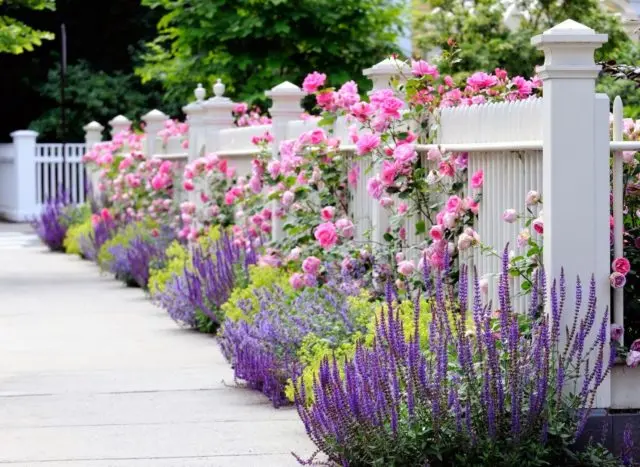
For an narrow-leaved look, a place can easily be found in the design of a garden of any style.
Variants of its application in landscape design are diverse:
- the creation of low hedges, planting along fences and along the perimeter of various buildings;
- front and middle rows in mixborders;
- fragrant and bright borders along garden paths;
- picturesque islands between stones in rock gardens, rockeries;
- spectacular decoration of various corners of the garden when grown in tubs and large flowerpots of an unusual shape;
- single landings against the backdrop of green lawns;
- in combination with plants intended to strengthen the slopes: juniper, rhododendron, subulate phlox, lilac;
- in flower beds with different varieties of roses;
- in compositions with herbs: sage, rosemary, thyme, thyme, mint, yarrow.
Useful properties of angustifolia lavender
Lavender angustifolia is not only beautiful and fragrant, but also a very useful plant. In addition to decorating the garden, she can successfully perform other roles:
- this is an excellent honey plant that attracts pollinators to the site – bees and butterflies;
- narrow-leaved lavender bushes, planted along the beds in the garden, repel insect pests during flowering;
- all organs of the plant contain essential oil, which is successfully used in perfumery and aromatherapy;
- narrow-leaved lavender flowers are used in culinary recipes;
- dry inflorescences, laid out on the shelves of the closet, protect woolen and fur clothes from damage by moths.
The narrow-leaved species has long been successfully used in traditional medicine, since it has many properties that are beneficial to human health. In particular, its dry flowers, stems, leaves and essential oil are used:
- as a sedative for insomnia, nervousness, migraines, chronic stress;
- for the treatment of disorders of the digestive system;
- in the fight against certain skin diseases;
- as an ingredient in soothing baths;
- with circulatory disorders;
- for the preparation of ointments effective for arthritis, rheumatism, sprains;
- as the main component of the means for the treatment of burns and wounds.
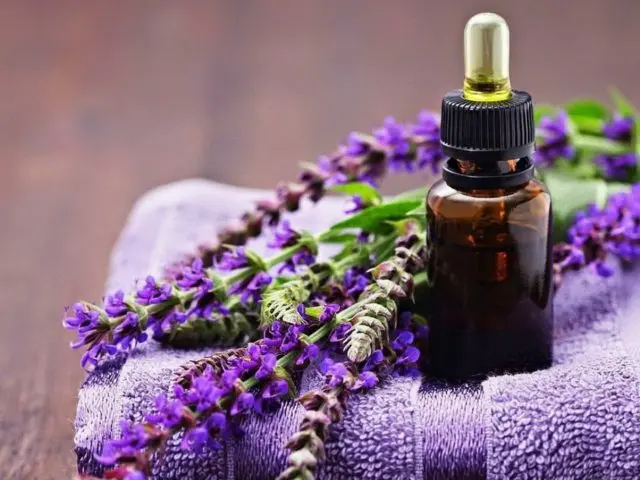
The essential oil of the plant is found in all its organs and is widely used in medicine, cooking, perfumery.
Growing narrow-leaved lavender at home
Although narrow-leaved lavender is not a traditional houseplant, it is also possible to grow it at home. The main problems with keeping this flower indoors are usually insufficient lighting and lack of fresh air. If you try to eliminate them by competently organizing the care of the plant, then it will be able to develop and bloom quite successfully.
The main subtleties of growing lavender angustifolia in a pot:
- Correct choice of plant variety. For indoor cultivation, low varieties of narrow-leaved lavender with good drought tolerance, such as Moonstead, Hidcote, Lavender Lady, Nana Alba, are best suited.
- Proper selection of capacity and soil for planting. To begin with, it is better to take a wide flowerpot with a diameter of at least 30 cm and a volume of 2-3 liters with drainage holes in the bottom. The soil should be loose and fertile. A mixture of sand with humus and leafy soil 1: 1: 2 or a ready-made purchased substrate is suitable.
- Germination of seeds. At the initial stage, it obeys the same rules as when sowing seedlings, which will be discussed in more detail below.
- Providing enough light, heat and fresh air. In nature, lavender angustifolia needs sunlight for at least 10 hours a day. In summer, it is advisable to take the pot with the plant to an open loggia or garden, and in winter, place it on the southern windowsill and organize additional lighting with a phytolamp.
- Regular watering with warm, settled water 2-3 times a week. The soil in the pot should be moist, but not sour. When watering lavender, narrow-leaved water must be applied so that it falls on the leaves, and then flows down them into the ground. In hot summer, the plant should be additionally sprayed with a spray bottle.
- Fertilization in liquid form 1 time in 2-3 weeks. Prior to budding, potted lavender is fed with nitrogen compounds. Then, throughout the entire growing season, phosphorus-potassium fertilizers are added.
- Proper pruning of the plant. It helps to form a neat spherical crown. Knocking out shoots of narrow-leaved lavender are cut with garden shears twice a year: before flowering and after it ends.
- Annual spring transplant to a larger container due to root growth. Starting from the age of 5-6, the narrow-leaved lavender bush growing at home can be divided. This will help rejuvenate the plant.
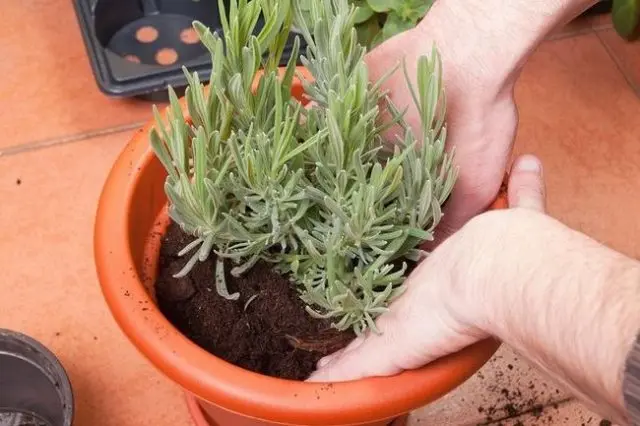
You can successfully grow lavender in an apartment if you provide it with the right care.
Planting and caring for narrow-leaved lavender in the open field
Lavender angustifolia is hardy and unpretentious, but it should be remembered that it is thermophilic and needs an abundance of light, as well as suitable soil. It is necessary to take into account the preferences of this flower, organizing planting and further care for it.
Deadlines
In regions with warm winters and a mild climate, narrow-leaved lavender seeds can be sown directly into the ground. The best time for this is October.
In the Moscow region and the middle lane, narrow-leaved lavender seeds are usually germinated for seedlings before planting in the ground. This is done in late February or early March. Thus, in May, young seedlings with 3-5 leaves can already be planted in the soil.
Site selection and soil preparation
The site where it is planned to place angustifolia lavender should have the following characteristics:
- open, well lit;
- protected from strong wind;
- soil – loose, calcareous, with good drainage properties;
- the optimal composition of the soil is sandy loam or light loam;
- its acidity level does not exceed 6,5.
The close occurrence of groundwater is unacceptable. Ideally, a bed or flower bed should be located on a slight hill, excluding stagnation of moisture at the roots.
Immediately before planting plants, the bed must be dug to a depth of 0,2-0,3 m, remove debris, and select weed rhizomes. Lavender angustifolia is not too demanding on soil fertility, but it grows well on soil rich in humus. It is recommended to pay for each sq. m garden area:
- 1 bucket of rotted manure or compost;
- 20-25 g of potassium salt;
- 35-50 g superphosphate.
How to sow narrowleaf lavender seeds
Growing lavender angustifolia from seeds involves their mandatory preplant preparation. For this purpose, the seed material is stratified at a temperature of about + 5 ° C for 1-2 months. Seeds are advised to be mixed with moistened sand, wrapped in a paper towel, and then in cling film, and put in the vegetable compartment of the refrigerator.
When planting in autumn in open ground, the narrow-leaved lavender seed is deepened into the soil by 0,3-0,4 cm. After that, the surface of the bed is lightly tamped and, if necessary, moistened.
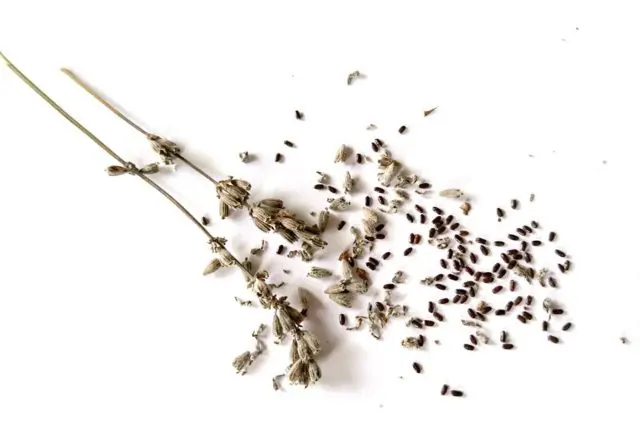
Seeds of narrow-leaved lavender can be germinated in advance for seedlings or sown directly in open ground
The seedling method of growing lavender angustifolia involves the following steps:
- A layer of drainage is poured at the bottom of a wide box or container. Then fill it with a substrate from a mixture of sand, humus and leafy soil.
- Stratified seeds are spread over the surface of the soil. They are sprinkled with a layer of sand about 3 mm thick, then sprayed with warm water from a spray bottle, covered with glass or a transparent polyethylene cap and placed in a warm (+ 15-22 ° C), well-lit place.
- After the emergence of seedlings, they organize supplementary lighting and remove the “greenhouse” for a short time every day, accustoming the growing narrow-leaved lavender to room temperature.
- When the seedlings have 2-3 pairs of true leaves, they are dived into separate pots or planted in a larger container, leaving a distance of at least 5 cm between them.
- At the end of May, narrow-leaved lavender is transferred to open ground. In the garden, holes are dug deep enough to fit the rhizomes of the seedlings. The distance between the planting pits depends on the size of an adult plant: for tall varieties of narrow-leaved lavender, it is 1,2 m, for medium and low – about 0,8-0,9 m. The roots of the seedling are cut a little, set it in a hole and covered with earth. Then it is watered abundantly.
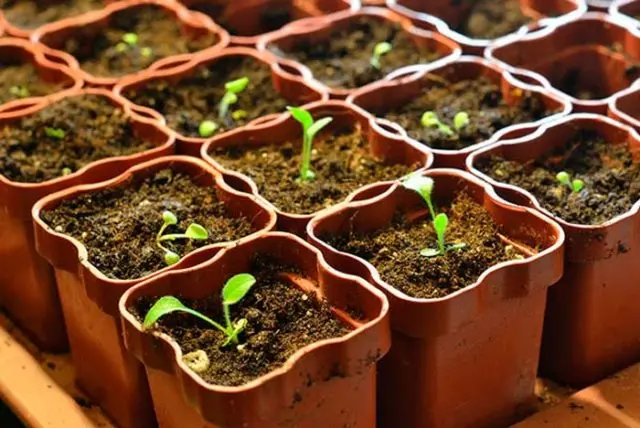
After the seedlings have 2-3 true leaves, they dive
Aftercare
Further care for the narrow-leaved lavender growing in the open field is not difficult. It is important to do it correctly.
Watering and top dressing
It is recommended to water the narrow-leaved lavender systematically, as the soil dries up. For the first time after transplanting, seedlings need the soil at their roots to be constantly moderately moist. Adult plants, if necessary, can tolerate the lack of watering for 2-3 weeks.
Lavender angustifolia does not require special dressings. As a rule, it is mulched in spring or spudded in autumn with compost or humus. If for some reason this has not been done, you can fertilize narrow-leaved lavender with a complex mineral composition for flowering plants at the bud stage.
Loosening, weeding, mulching
Every time after watering or rain, it is advisable to carefully loosen the soil between the plants and weed out. However, these procedures can be carried out less frequently if, immediately after planting the narrow-leaved lavender, the soil at its roots is mulched with a layer of peat or compost.
If the bushes are old, in spring and autumn they need to be planted high in order to allow new shoots to grow.
Trimming
The first inflorescences that appear on young seedlings should be removed. This will give young lavender angustifolia the opportunity to get stronger and grow roots.
Shrubs need to be pruned annually. After the narrow-leaved lavender has faded, wilted inflorescences should be removed. In autumn, you will need to shorten the shoots, maintaining the spherical shape of the crown.
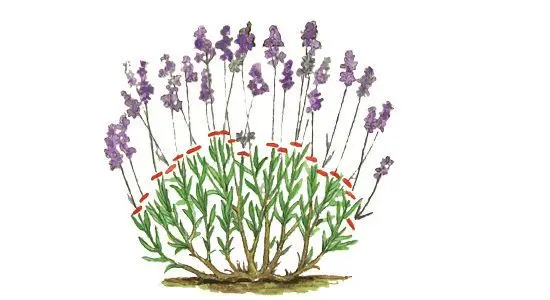
Proper and timely pruning of lavender helps to form a neat crown.
Anti-aging pruning is carried out after the narrow-leaved lavender reaches 10 years of age. All branches must be shortened to 5 cm. You can do the same with a young plant that does not please with abundant flowering.
Preparation for winter
If in the region where narrow-leaved lavender grows, the temperature drops below -25 ° C in winter, it must be covered for the period of frost. After pruning, the bushes are covered with coniferous spruce branches or a “breathing” agrofibre is placed on top.
If the winters in the region are warm and mild, the narrow-leaved lavender can be left uncovered.
Pests and diseases
There are not so many pests and diseases that can cause serious damage to this plant. However, the health risks of angustifolia lavender may include:
- Gray rot (gray mold) – a fungal disease that develops when the soil is waterlogged or plantings are too thick. At first, the flowering tops of the shoots turn brown and die, then the infection affects the remaining above-ground organs. After the discovery of the disease, the most infected specimens of angustifolia lavender should be removed and burned, and the remaining plantings should be treated with Bordeaux mixture (1%) or fungicides.

The occurrence of gray rot is often facilitated by waterlogging of the soil or too dense plantings.
- Penny slobbering – a parasitic insect that eats large holes in lavender leaves. It also significantly spoils the decorative appearance of the plant due to a foam-like substance sticking to the stems, with which it protects its larvae. You can get rid of the penny by washing the lavender plantings with a narrow-leaved stream of water from a hose.

The larvae of the slobber pennitsa are protected by a layer of a viscous substance resembling foam
- rainbow beetle – a pest that eats the leaves and flowers of lavender, depriving it of the opportunity to develop. Heavily infected bushes are advised to dig and destroy. Adult insects are usually harvested by hand.

Rainbow beetle damages lavender leaves and flowers
Conclusion
Narrow-leaved lavender is a bright, spectacular and fragrant garden decoration that can please the eye for many years and does not require complicated care. You can successfully grow this evergreen beauty as a houseplant if you provide it with enough light and heat. Reviews of gardeners about narrow-leaved lavender agree that this flower is little affected by pests and diseases and is undemanding to environmental conditions. A wide variety of varieties allows you to choose the option suitable for growing in almost any region. In the event that the winters are severe, you can plant the plant in a tub and, after the end of the warm period, take it from the garden into the room in order to put it out again under the open sky for the next season.












